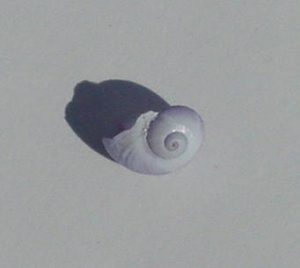
Last month, I was walking the beach with friends who live out of state. Because I can’t help myself, I would stop periodically and point out random plants, shells, or washed-up sea creatures. While familiar with jellyfish, they were both taken aback by the bright blue-purple blob of goo we found on the shore. A Portuguese man ‘o war (Physalia physalis), especially up close, is an incredibly striking organism. Named for the intimidating 15th century European sailing warships, both the invertebrates and the ships possess large wind-powered sails and a powerful method of attack.
Portuguese man ‘o wars can be confused with their close relatives, the blue button (Porpita porpita) and by-the-wind-sailors (Velella velella) due to their similar coloring and tentacles. However, the other two are smaller and do not have the same large air-filled sac. The by-the-wind sailor has a triangular “sail” used for directional floating, while the blue button is a flat circle, resembling the cross section of a tree. Because it has no fins, flippers, or legs, the Portuguese man ‘o war and similar gelatinous creatures are considered large plankton that simply drift through the water, pushed by wind, waves, and currents. Most people think of something microscopic when they hear the world “plankton,” but the word comes from the Greek for “drifter” refers to any organism lacking a mode of self-transportation.

Portuguese man ‘o wars are not single organisms but are siphonophores composed of a colony of organisms called zooids. The individual zooids work together to make the system function, and have different jobs within the colony, ranging from forming the float and filling it with gas to digesting food and creating nematocysts. The float or “sail” or is oriented at a left or right sailing form, with the left-sailing ones more common in the Gulf.

Gooseneck barnacles and sea turtles will eat Portuguese man ‘o wars, and even ghost crabs will drag stranded individuals to their burrows and feed on them. However, their primary predators are three species of purple storm snails (Janthina spp). These interesting snails create a floating raft by wrapping mucus around air bubbles. To attack a man-of-war, the snail relies on its proboscis, which uses a rasping mechanism to eat and break down tissue. The largest of the purple storm snails are only 4 cm, but a pair of them can easily eat a Portuguese man ‘o war twice that size in a day.
While beautiful, it is important to look but not touch a Portuguese man ‘o war. The colorful air bladder itself is not dangerous, but the dozens of tentacles are full of toxins. Like other zooids and jellyfish, the tentacles are lined with nematocysts, which are essentially locked and loaded little triggers than release venom upon contact. These are intended to stun and kill anchovies and other small fish for food, but they can fire on a human as well. The stings are painful and can be dangerous for people with allergic reactions.
 0
0
